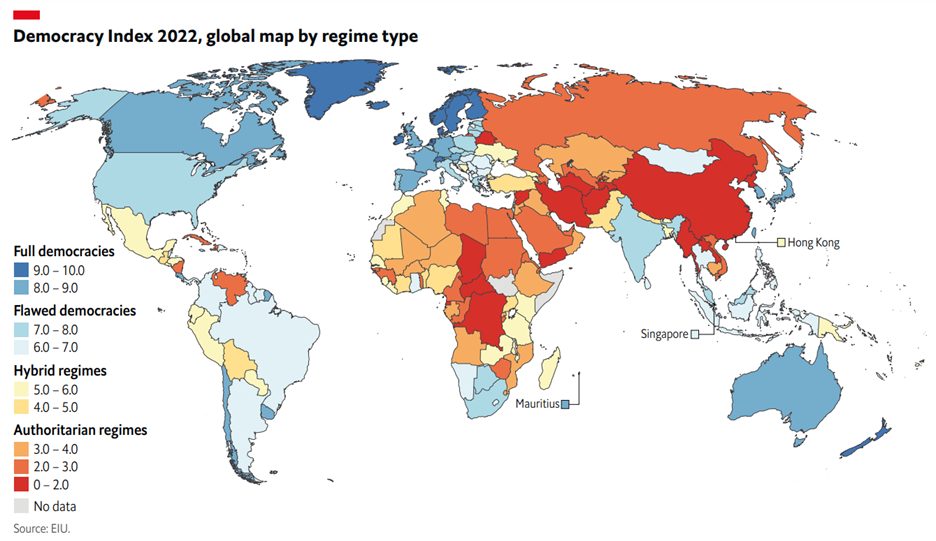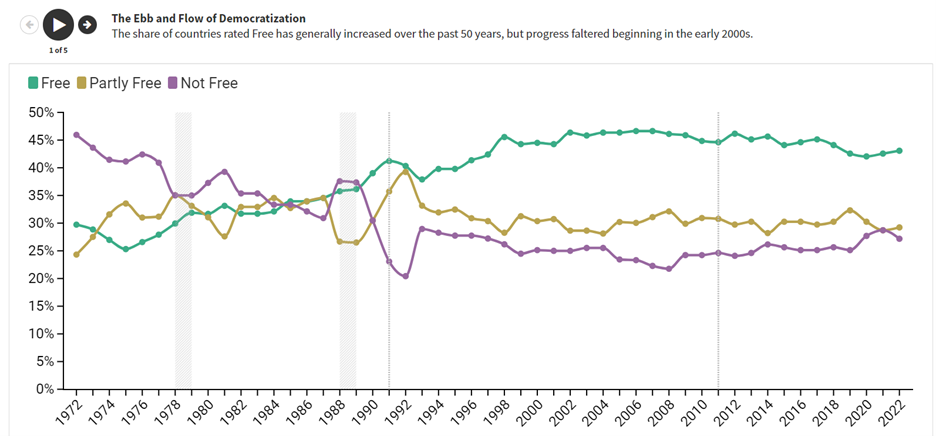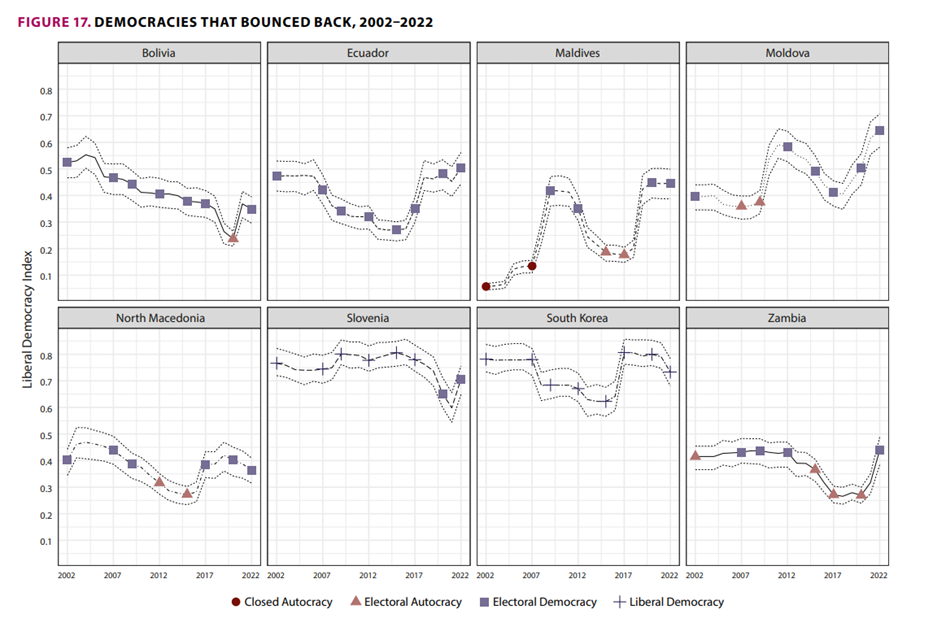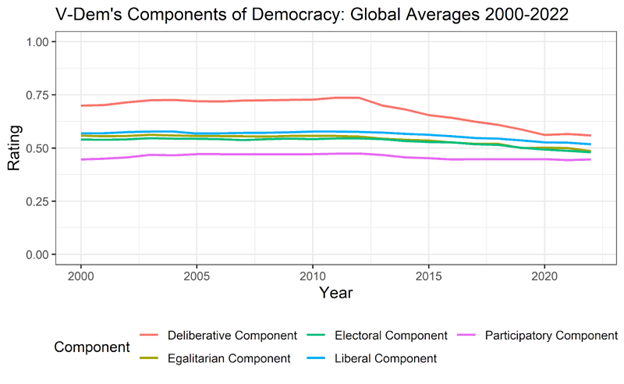 Democracy remains strong in Western Europe and North America but has stagnated or declined in other regions. Source: Economist, Economist Intelligence Unit 2023 Democracy Report.
‘Tis the season for the release of annual democracy, human rights, and governance (DRG) indicators. These metrics capture global, regional, and country trends in democracy and governance over time. Policymakers, advocacy groups, and the media rely upon these data sources to frame their positions on key DRG issues. They are important to monitor as they provide information on local needs and dynamics that may affect ongoing USAID programs. This issue of the Learning Digest summarizes lessons from the latest indicator metrics and annual reports of prominent DRG sector public policy organizations.
This edition of the DRG Learning Digest examines the following topics:
- From Decline to Stagnation?
- Democracy in Context
- Mastering Metrics: Is Democracy Really Declining?
Please also make use of DRG Evidence and Learning Team resources! See text box at the end for more details.
From Decline to Stagnation?
In many ways, little changed between 2021 and 2022. Varieties of Democracy (V-Dem), for example, classified 72 percent of the world population as living in autocracies in 2022, up from 70 percent in 2021. Freedom House reports that 84 of 195 (43.1 percent) countries are free in 2022, compared to 82 of 195 (42.1 percent) in 2021. For the Economist Intelligence Unit (EIU), 72 of 167 countries they cover (43.1 percent) are classified as democracies and the democracy index improved slightly from 5.28 in 2021 to 5.29 in 2022.
Different organizations interpret that stagnation differently. Freedom House believes “the struggle for democracy may be approaching a turning point” because the rate of autocratization is at its lowest level since the democratic decline began in 2006. For EIU, the stagnation is “a dismal result” because of expectations that democracy scores would rebound as pandemic-related prohibitions were lifted in 2022. However, the positive effect of removing COVID-19 restrictions on individual freedoms was canceled out by other negative developments globally.
 Democracy has made immense progress since the 1970s, but progress halted and even began declining over the last two decades. Source: Freedom House, Freedom in the World 2023.
The overall scores belie substantial regional variation. V-Dem found that while the level of democracy enjoyed by the average global citizen in 2022 is down to 1986 levels, the decline is most dramatic in the Asia-Pacific region, which is back to levels last recorded in 1978. Democracy levels in Western Europe remain strong and have, according to EIU, recovered to their pre-pandemic levels. Western Europe is also the only region in the world where rule of law improved in more countries than it declined, according to the World Justice Project. Democracy levels in North America also remain strong, though they have declined in recent years. New reports on Latin America and sub-Saharan Africa highlight the major disjuncture between people’s democratic desires and their government’s democratic governance. A World Justice Project report on Latin America showed that, “The majority of people in Latin America and the Caribbean believe their government is using misinformation to shape public opinion in their favor.” Additionally, an Afrobarometer report cited perceived corruption and lack of responsiveness as major issues, noting that “Africans want more democratic and accountable governance than they think they are getting.”
How has this autocratization occurred? V-Dem and Freedom House both show that autocrats attack free expression by censoring the media, repressing civil society organizations, and reducing academic freedom and freedom of discussion. The ongoing media repression is corroborated by a Reporters Without Borders 2023 report, which says the environment for journalism is “bad” in 70 percent of countries. Beyond curtailing free expression, elected leaders have also eroded democratic institutions and rewritten the rules of the game to maintain power, as in El Salvador, Tunisia, and Hungary. Democratically elected leaders circumventing democratic rules remains the hallmark of the third wave of autocratization.
The democratic decline coincides with a decline in material outcomes. For the third consecutive year, the 2023 Legatum Prosperity Index finds that prosperity continues to plateau around the world, primarily due to the deterioration of democratic institutions and processes. An Afrobarometer report noted that lived poverty—the frequency with which people go without basic necessities—has been increasing since 2016, after decreasing from 2005–2015. A continent-wide slowdown began in 2014, but economic growth then decelerated sharply in 2016 and became a recession in 2020 as a result of the COVID-19 pandemic. Economic growth in Africa is recovering but numerous countries are struggling with debt. Food insecurity is a growing problem in the Middle East and North Africa, and that region is the only one where poverty and extreme poverty are increasing. V-Dem’s Case for Democracy report and policy briefs continue to catalog the benefits of democracy, showing how our current era of autocratization costs citizens globally in terms of health, education, public services, and other aspects of human well-being.
Democracy in Context
The 2022 metrics also took a moment to put the current era of autocratization into context. Though we are in the midst of the third wave of autocratization, V-Dem notes that the substantial gains made during the “third wave of democratization” remain and that the world remains more democratic today than in the early 1970s. When Freedom House issued their first edition of its global survey in 1973, only 44 of 148 countries were rated free. Today, 84 of 195 countries are free. Over the past 50 years, democracies have not only emerged from deeply repressive environments but also proven to be remarkably resilient in the face of new challenges. We should not forget the progress made over the past 50 years due to the struggles of the past 20.
The 2022 annual metrics reflect this resilience. One year after noting that autocratization, once begun, rarely reverses. V-Dem cited eight examples of countries restoring democracy after a period of autocratization: Bolivia, Moldova, Ecuador, Maldives, North Macedonia, Slovenia, South Korea, and Zambia, which all started down the path to autocratization but reversed the trend, showing the resilience of their democracies. This bodes well for democratic recovery in the current era of autocratization. Researchers cited several factors common to the eight cases: 1) large-scale popular mobilization against incumbent; 2) judiciary reversing executive take-over; 3) unified opposition coalescing with civil society; 4) critical elections and key events bringing alternation in power; and 5) international democracy support and protection.
 Eight countries “bounced back” and had their democracy scores increase after a period of decline. This shows that democracy is resilient and backsliding is reversible. Source: V-Dem, Defiance in the Face of Autocratization.
Along with 2022 displaying the resilience of democracy, Freedom House notes that 2022 also showed that authoritarians are dangerous but not unbeatable. Authoritarians have focused on political control at the expense of competence, exposing the limits of their authoritarian models to the world: Beijing’s inhumane “zero-COVID” restrictions, Moscow’s destructive war with Ukraine and their corrupt and feckless military leadership, Caracas’ policies that have resulted in shortages of electricity and food, and Tehran’s long history of discrimination and brutality.
Mastering Metrics: Is Democracy Really in Decline?
Usually the last section of the metrics edition has measurement lessons. This year, let’s put those measurement lessons into practice by evaluating competing claims about democracy’s decline. Organizations summarized in this Learning Digest suggest democracy has been and is still declining. However, a paper by Little and Meng (L&M) has stirred significant debate in the sector by arguing that democracy is not declining when you look at “objective” indicators like election results. They argue that V-Dem’s ratings, based on experts’ perceptions, have become more strict over time, resulting in the appearance of democratic decline despite global democratic stability. V-Dem and other academics have responded, questioning L&M on methodological grounds.
Academic debate is part of a healthy democracy! Rather than wade into the question of who is right and who is wrong, let’s consider reasons that election results might not align with expert coding. We’ll consider the merits of three possible explanations:
- There are definitional differences between V-dem’s maximalist definition of democracy and the minimalist definition of procedural democracy used by L&M.
-
Election results are a lagging indicator and the recent decline in quality of democracy as measured by expert coders will affect future election results.
- There are changes in coder bias over time (what L&M propose).
Definitional differences
V-Dem uses a more expansive definition of democracy than L&M. L&M’s definition is focused mainly on procedural elements of elections, whereas V-Dem’s definition also includes liberal elements like access to justice, property rights, and equality before the law. Other V-Dem indices are broader still, including freedom of expression and quality of public deliberation. These definitional differences could cause different conclusions about democracy if the indicators common to both definitions have changed little but the indicators unique to V-Dem have changed substantially. For example, V-Dem data shows the most substantial decline is in democracy’s Deliberative Component, which measures respectful dialogue and the extent to which “public reasoning focused on the common good motivates political decisions.” The electoral component only marginally declines. Based on these figures, V-Dem and L&M disagree, in part, due to their differing definitions of democracy.
 V-Dem’s Deliberative Component Index of democracy has experienced the steepest decline over the last decade. L&M’s paper focuses on the Electoral Component Index of democracy, which, similar to other components of democracy, has only declined a small amount. Source: V-Dem.
Election results are a lagging indicator
Along with definitional differences, a decline recorded by expert raters might not be reflected in election results if expert coders are capturing things that weaken the overall democratic system but have not yet affected elections. Many phenomena have lagged effects and not all indicators possess the granularity to detect incremental changes that eventually lead to a large change. For example, consider the process of water freezing to ice. If you only measure whether or not it is ice, you will miss the water cooling from 80 degrees to 33 degrees. It is possible that V-Dem is cataloging democratic declines that will eventually manifest in election results.
Coder bias
L&M suggest that V-Dem’s measurement of democratic decline is due to coder bias. Coder bias occurs when the coders misperceive the phenomenon they are rating. In this case, L&M argue that V-Dem’s coders are rating countries more harshly now than in years past, causing the appearance of democratic decline. Coder bias could cause V-Dem’s democracy scores to decline over time because 1) democratic standards have increased over time, and 2) modern media increases awareness of democratic backsliding in general and of specific events, like electoral intimidation and executive overreach. Interpreting events is also difficult—how should a coder adjust their rating when there is an unsuccessful attempt at eroding democracy? Should the mere attempt be considered evidence of democratic erosion, or should the lack of success be taken as evidence of democratic resilience? These types of questions may be influenced by a coder’s pre-existing beliefs and how the events were covered in the media. For those and other reasons, coder bias is a plausible explanation for the difference between objective and perceptual measures.
Conclusion
Is democracy in decline? The answer likely depends on how one defines and measures democracy. For definitions of democracy that include free expression and deliberation, the democratic decline appears real. It’s plausible that coder bias accounts for some of the recent decline in democracy scores, but it’s equally plausible that expert coders are detecting changes missed by “objective” indicators like election results. Measuring abstract concepts like the strength of democracy across time and space is challenging, but the ongoing academic debate about the topic is a sign of a healthy democracy!
Further Assistance
For further assistance with DRG metrics, please contact Chris Grady and the DRG Center Evidence and Learning Team at cgrady@usaid.gov and ddi.drg.elmaillist@usaid.gov.
Recent DRG Learning Events
Tuesday Group: Online Gendered Disinformation: The Trojan Horse that Threatens Democracy
On June 13, Lucina Di Meco and Kristina Wilfore, co-founders of She Persisted, presented key findings from a five-year study investigating patterns, impacts, and modus operandi of gendered disinformation campaigns against women in politics, featuring new evidence from Brazil, Hungary, India, Italy, and Tunisia. The #MonetizingMisogyny research series highlights the intentional use of gendered disinformation to weaken democratic stability. The case studies illustrate how gendered disinformation has been used by political movements, and at times the government itself, to undermine women's political participation and to weaken democratic institutions and human rights. Crucially, the research also looks at the responsibilities and responses that both state actors and digital platforms have taken—or most often, failed to take—to address this issue and suggests solutions focused on legislative frameworks, corporate accountability, and solution-oriented research and programs.
Use Our Resources!
Welcome to the DRG Learning Digest, a newsletter to keep you informed of the latest learning, evaluation, and research in the Democracy, Human Rights, and Governance (DRG) sector. Views expressed in the external (non-USAID) publications linked in this Digest do not necessarily represent the views of the United States Agency for International Development or the United States Government.
Don't forget to check out our DRG Learning Menu of Services! (Link only accessible to USAID personnel.) The Menu provides information on the learning products and services the Evidence and Learning Team offers to help you fulfill your DRG learning needs. We want to help you adopt learning approaches that emphasize best fit and quality.
The Evidence and Learning Team is also excited to share our DRG Learning, Evidence, and Analysis Platform (LEAP) with you. This Platform contains an inventory of programmatic approaches, evidence gap maps, the DRG Learning Harvest, and inventories of indicators and country data portraits - all of which can be very useful in DRG activity design, implementation, evaluation, and adaptation. Some of these resources are still being built, so check back frequently to see what has been newly added.
The DRG Learning Harvest on LEAP is a searchable database of DRG learning products, including summaries of key findings and recommendations, drop-down menus to easily find documents related to a particular country or program area, and links to the full reports on the DEC.
Our friends at the Varieties of Democracy (V-Dem) Institute are also seeking to expand their research partnership with USAID on the complex nature of democracy by inviting research questions from you for V-Dem to work on. If there's a DRG technical question you've been wondering about, please email the Evidence and Learning Team at ddi.drg.elmaillist@usaid.gov.
We welcome your feedback on this newsletter and on our efforts to promote the accessibility, dissemination, and utilization of DRG evidence and research. Please visit the DRG Center's website for additional information or contact us at ddi.drg.elmaillist@usaid.gov.
|